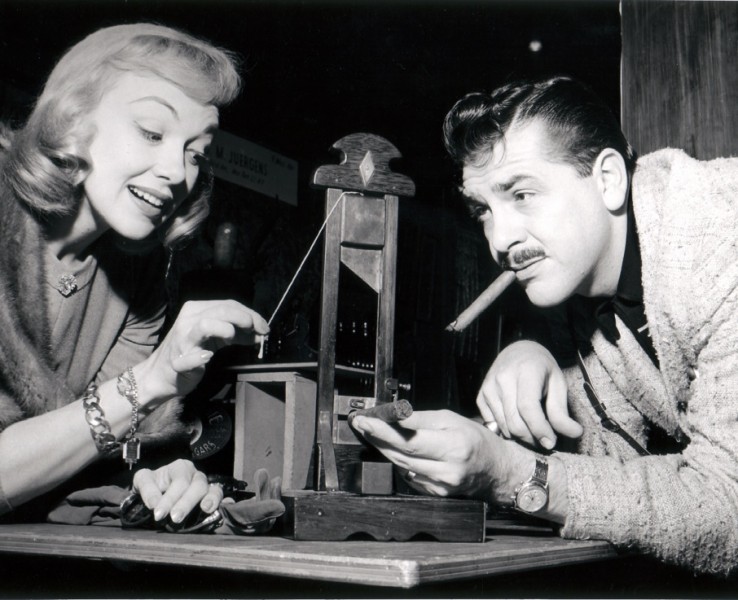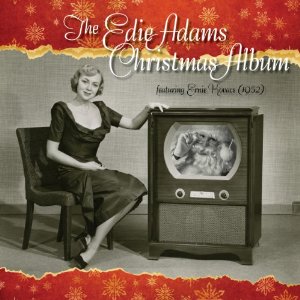
THE EDIE ADAMS CHRISTMAS ALBUM featuring ERNIE KOVACS (1952)
Omnivore Recordings
Certainly one of the benefits of the DVD era has been the reissuing of brilliant, nigh on to surreal TV shows Ernie Kovacs presented on various networks in the 1950s. Mustachioed, with an ever-present cigar and impish twinkle in his eye, Kovacs was as unpredictable a live TV presence as the medium has ever seen, with his clever sight gags and verbal agility paving the way for a more sophisticated–and subversive–brand of humor than the mainstream big-name comedians of the ‘50s were offering. Kovacs was more than a decade ahead of his time, but his wife and co-conspirator, Edie Adams, served as a façade of normalcy in the Kovacs troupe but was never a second banana.
 Juilliard-trained as a vocalist, a graduate of the Columbia School of Drama, a student at the Actors Studio and at the Traphagen School of Fashion Design, a “Miss U.S. Television” beauty contestant winner in 1950, Adams–born Edith Elizabeth Enke in Kingston, Pennsylvania–had a number of appealing career options ahead of her when Kovacs’ producer saw her on Arthur Godfrey’s Talent Scouts in 1951 and invited her to audition for the Kovacs show. Well versed in classical music, she knew only three popular songs of the day, sang them and was hired, not by Kovacs, whom she met later and was wed to in 1954 (his wooing of her included mariachi bands materializing at odd moments to serenade the girl of his dreams), but by his producer, whom Kovacs claimed always had the final say in personnel matters. On a show known variously as Kovacs Unlimited, The Ernie Kovacs Show and The Ernie Kovacs Rehearsal, airing on three different networks (CBS, NBC and DuMont), from late 1952 through April 1955, Edie Adams became something akin to the ballast on a ship Kovacs purposely steered into choppy comedic waters. A beautiful woman with an air of sophistication about her but also great personal warmth of the girl-next-door kind, Adams proved a versatile player on the Kovacs roster: she could do comedic bits on her own, was a perfect foil for her boss’s unpredictable antics; and because she was a skilled, expressive singer, she was an isle of serenity offering respite from Hurricane Kovacs.
Juilliard-trained as a vocalist, a graduate of the Columbia School of Drama, a student at the Actors Studio and at the Traphagen School of Fashion Design, a “Miss U.S. Television” beauty contestant winner in 1950, Adams–born Edith Elizabeth Enke in Kingston, Pennsylvania–had a number of appealing career options ahead of her when Kovacs’ producer saw her on Arthur Godfrey’s Talent Scouts in 1951 and invited her to audition for the Kovacs show. Well versed in classical music, she knew only three popular songs of the day, sang them and was hired, not by Kovacs, whom she met later and was wed to in 1954 (his wooing of her included mariachi bands materializing at odd moments to serenade the girl of his dreams), but by his producer, whom Kovacs claimed always had the final say in personnel matters. On a show known variously as Kovacs Unlimited, The Ernie Kovacs Show and The Ernie Kovacs Rehearsal, airing on three different networks (CBS, NBC and DuMont), from late 1952 through April 1955, Edie Adams became something akin to the ballast on a ship Kovacs purposely steered into choppy comedic waters. A beautiful woman with an air of sophistication about her but also great personal warmth of the girl-next-door kind, Adams proved a versatile player on the Kovacs roster: she could do comedic bits on her own, was a perfect foil for her boss’s unpredictable antics; and because she was a skilled, expressive singer, she was an isle of serenity offering respite from Hurricane Kovacs.
Edie Adams also did a great service for historians in paying a transcription service to record the show’s audio so she could review her musical performances with an eye towards improving her presentations on future shows. From these surviving transcriptions, Adams’s son, Josh Mills (from Edie’s marriage to Marty Mills, a few years after Kovacs’s death in a car accident in 1962), has compiled a delightful collection of Yuletide songs his mother sang on the Kovacs show in its early years. Ernie, of course, makes his presence felt, literally, in both comical and straight man fashion: no great shakes as a singer he, Ernie nevertheless contributes a warm harmony vocal to Edie’s on a lovely treatment of “Silver Bells,” accompanied only by a piano that takes on a music box quality at points. But there’s more than meets the ear here when Ernie and Edie sing together, and Josh nails it in his affectionate liner notes: “Listening to these Christmas recordings from the 1950s, it’s clear to me that Edie Adams and Ernie Kovacs were hopelessly and totally in love.”
As heard on The Edie Adams Christmas Album and live on Kovacs Corner, December 19, 1955, on NBC, Edie Adams performs ‘Christmas in Killarney.’
Most of the songs, though, are simply Edie solo, with only a piano backing her, giving the album the feel of either a rehearsal or a recital in its plain, unadorned offerings, some of them clearly done with no consideration of mic placement—no strings, no brass, no small combos, only an unidentified pianist who impresses with his witty, nimble excursions on Edie’s cheery rendering of “Let It Snow! Let It Snow! Let It Snow!” and the sensitivity of his reverent backing on “I Wonder As I Wander.” But it’s Edie’s show, and hearing her clear, bright voice again—so reminiscent of Doris Day’s–and being reminded of her savvy as a singer—a wonderful sense of phrasing and an acute ear for a song’s dynamics—makes this one of those Christmas albums worthy of being cued up periodically throughout the year. Her take on “The Christmas Song”—with the pianist embroidering it with periodic glissando runs—really heightens the song’s beauty in its basic, stripped down form. On a deeply felt version of “I’ll Be Home for Christmas,” there’s nothing casual about her vocal—deeply invested emotionally in the song’s message, she brings the full force of her classical training to bear on the song’s abiding yearning for home, family and friends with rich, full phrasing at points, a wondrously sustained falsetto at others, and throughout a genuine effort to reach the listener with the song’s message. Elsewhere she does a terrific job with a blues-tinged pop treatment of “Blue Christmas” (this would have been a few years before Elvis cut his classic version); skips merrily along in “It’s a Marshmallow World,” despite some Kovacs antics that trip her up momentarily, and “Winter Wonderland”; adopts her best Irish brogue in romping through “Christmas in Killarney” (something’s going on with Ernie on this one, as about midway through the sound of birds chirping suddenly appears and Kovacs laughs and says, “No rehearsal!”); and closes with a touching, saloon-style treatment of “What Are You Doing New Year’s Eve.”
Edie Adams performs ‘Good For Nothin’ Joe’ from her 1962 album Behind Those Swingin’ Doors.
Not the least of this album’s virtues are the liner notes penned by Josh Mills. These fill in some of the historical details about how the album came to be, but are even more valuable for the history he shares of his memories of Christmas with his mother. On the one hand, he describes indulging her fondness for cooking, even though “she wasn’t a good cook” (and describes our great good fortune in not having to eat her microwave lasagna, “made with tofu instead of ricotta cheese”); on the other, he describes spending Christmas Eves in Jack Lemmon’s home with a big spread catered by Chasen’s restaurant and how one of Lemmon’s other guests, Walter Matthau, taught young Josh a “mind reading card trick.”
On the series finale of The Lucy-Desi Comedy Hour, Edie Adams performs ‘That’s All.’
So this most unexpected holiday albums—because who knew?—turns out to be one of the gems of the 2012 crop. Its informality may not be to everyone’s taste, but that same seeming informality also gives it a greater intimacy than some larger-scale Christmas projects have to offer. It does right in reminding us what a gifted all-around artist Edie Adams was (did I mention she was perfect as a manic Sid Caesar’s wife in Stanley Kramer’s great screen comedy, It’s a Mad, Mad, Mad, Mad World?), but especially shines a much-deserved spotlight on her vocal artistry. One of her albums is titled There’s So Much More, and boy if that’s not an understatement. Here, her charming personality, intelligent and respectful approach to the material and uplifting spirit have produced a seasonal outing that sounds like home. What better recommendation than that for a Christmas album?


